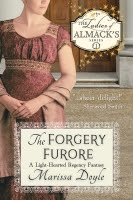 As Regina mentioned in Part 3, a popular vacation pastime for 18th and early 19th century people was the visiting of the large country estates of the rich and famous. Though it seems odd to us today, back then it was considered perfectly permissible. A lot of those houses are still open for viewing today…but today we’re going to visit a popular stately home that alas no longer exists, yet was quite famous in its day for its sheer…well, over-the-top-ness.
As Regina mentioned in Part 3, a popular vacation pastime for 18th and early 19th century people was the visiting of the large country estates of the rich and famous. Though it seems odd to us today, back then it was considered perfectly permissible. A lot of those houses are still open for viewing today…but today we’re going to visit a popular stately home that alas no longer exists, yet was quite famous in its day for its sheer…well, over-the-top-ness.
The Beckford family of Wiltshire was a fabulously wealthy one, thanks to its extensive plantation holdings in the West Indies which gave it a preeminent place in the sugar import market. Young William, heir of the family, got nothing but the best growing up—piano lessons from the young Mozart, for example—so when he came of age in 1781, he threw himself a party that cost ₤40,000. Um, wow.
However, scandals within a very few years drove him from England and his popular place in society. Despite his vast wealth, his life was not a happy one. He lost his young wife in childbirth while in exile on the continent, and spent the next several years traveling, writing (among his works was a well-known Gothic novel, Vathek) and collecting art. In 1796, much to everyone’s surprise, he decided to return to England and build himself a new house to house his art collection…in the form of a Gothic cathedral. He had the former Beckford home, Fonthill Splendens, torn down, and hired the brilliant but troubled architect James Wyatt to build it for him.
 What emerged was one of the largest private homes in England. Fonthill Abbey featured 50 foot high windows, three-hundred foot corridors, staircases of enormous height and width…and a 50 foot table in the dining room, which seemed odd as no one would visit or even speak to Beckford (remember that scandalous past?) Yet alongside this excess, most of the bedrooms were small, stark, and bare, and over a dozen of them didn’t even have windows. Up to five hundred men were at work on the enormous house at any given time, and due to Wyatt’s frequent absences (he was notoriously unreliable, and often disappeared for months at a time on alcoholic sprees), Beckford himself did much of the directing of the building and landscaping of his monstrous home.
What emerged was one of the largest private homes in England. Fonthill Abbey featured 50 foot high windows, three-hundred foot corridors, staircases of enormous height and width…and a 50 foot table in the dining room, which seemed odd as no one would visit or even speak to Beckford (remember that scandalous past?) Yet alongside this excess, most of the bedrooms were small, stark, and bare, and over a dozen of them didn’t even have windows. Up to five hundred men were at work on the enormous house at any given time, and due to Wyatt’s frequent absences (he was notoriously unreliable, and often disappeared for months at a time on alcoholic sprees), Beckford himself did much of the directing of the building and landscaping of his monstrous home.
The process did not run smoothly. The main tower, planned to be three hundred feet tall, collapsed twice before finally staying put. The house was finally completed in 1813…which year also saw Wyatt’s death in a carriage accident.
Beckford lived alone in the gloomy splendor of his house for the next ten years, only entertaining once when Lord Nelson and Emma Hamilton spent Christmas with him. Unfortunately, the outrageous cost of his building (not only the Abbey itself but a twelve foot high wall extending for twelve miles around his lands) combined with a drop in the price of sugar and the loss of some of his Jamaican plantations led to his needing to sell his white elephant abbey…which he did in 1823, amazingly enough, for the tidy sum of ₤300,000.
The new owner of Fonthill Abbey, gunpowder magnate John Farquhar, rarely visited his new acquisition, but happened to be there at Christmas 1825 when, for the third and final time, the 300-foot tower of the Abbey collapsed, demolishing about a third of the house with it. Farquhar himself died the following year, having neglected to write a will, and none of the relations arguing over his fortune was interested in taking on Fonthill. It was torn down, and only the gatehouse and a small portion of the once enormous house remain.
 And Beckford? He took his money and moved to Bath, erecting a shorter (only 120 feet tall) and much more solidly built tower in which to house some of his art treasures. Though Fonthill is long gone, you can still visit his Lansdown Tower today…just as inquiring young ladies might once have done.
And Beckford? He took his money and moved to Bath, erecting a shorter (only 120 feet tall) and much more solidly built tower in which to house some of his art treasures. Though Fonthill is long gone, you can still visit his Lansdown Tower today…just as inquiring young ladies might once have done.





2 comments:
Simply amazing. "A fool and his money are soon parted"
Oh, definitely! I would so have loved to be an early 19th century tourist and have seen this place...and his art collection, which was pretty amazing as well.
Post a Comment